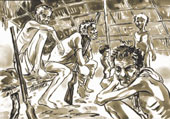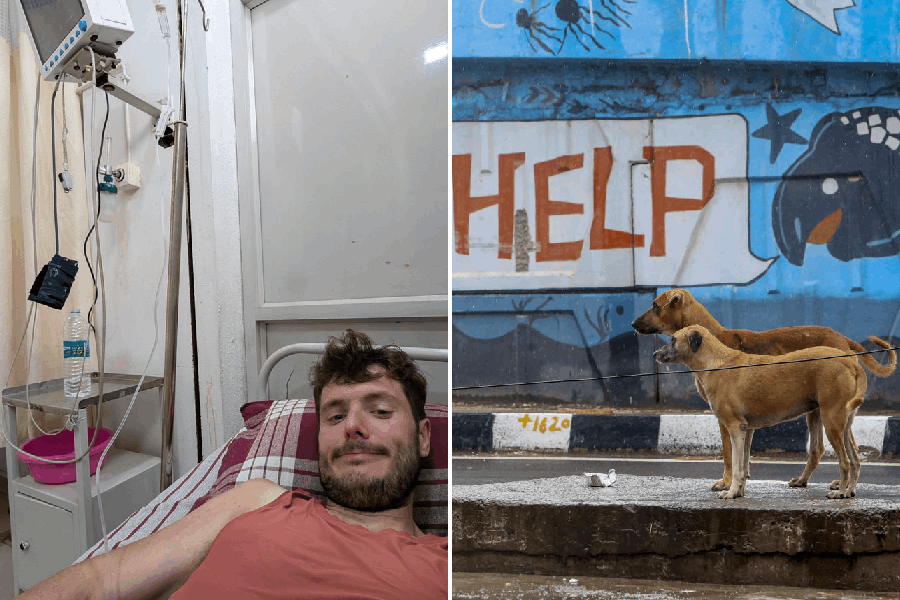 |
Science-fiction writers have often fantasised about some magic to do away with food. If a pill could kill hunger, they argued for example, it would save people a lot of bother. Somehow they never stumbled upon a wild root, gethi or genthi, that sustained a large number of people in Manatu and Ranka, both in the district of Palamau. Women had to hunt for the root and develop some expertise to distinguish when and which ones would turn poisonous. Occasionally they died when they made a mistake. But generally they appeared happy enough to boil the root and eat it with salt and pepper. They of course had very little choice. Activists complained that the root had nothing nutritious but merely killed their appetite. What?s more, without people realising it, their immune system would get progressively weaker and one day it would be the genthi that would kill them, the activists cribbed bitterly.
Memories of that first visit in the mid-Seventies came rushing back this week as Jharkhand debated over reports of starvation deaths from, you guessed it, Ranka, Manatu and adjoining areas. Nobody had died of hunger, asserted the chief minister first. He then declared that if people had indeed starved to death, the UPA government at the centre had to be held responsible. He still took off on a flying visit to ascertain the truth and then ended up ordering an official inquiry. The drill must be familiar to the people of Palamau, a rain-shadow area that traditionally receives less than its legitimate share of rainfall. Its impoverished labourers ended up in the stories of Mahashweta Devi. A small part of the district is, ironically, verdant green, driving filmmakers like Satyajit Ray to shoot Aranyer Din Ratri (Days and Nights in the Forest). But when Goutam Ghose filmed a sequel, Abaar Aranye (Back to the Forest), he held the shooting in North Bengal. Palamau is no longer safe for the babus, police or the outsider. Reports of landmine explosions continue to hit the headlines of local newspapers. Police call them ?cane bombs?, actually explosives filled in milk-cans and buried underground, to be detonated at will by the extremists.
But when was Palamau ever safe? And, if so, for whom? Hunger, they say, is sharper than the sword. In Palamau, however, it did not drive people to take up arms, though several impoverished families desperately flaunted firearms, not just for security but also to preserve some sense of dignity. Many of the men who strutted around with rifles, had dull eyes, an emaciated look and drooping shoulders. Guns, they would explain, were needed to ward off the wild animal, to kill birds or wild boars and of course to protect themselves. It also indicated a person?s well-being and station in life. If you could flaunt a firearm, it became easier to obtain a ration card or even a temporary job in the many projects undertaken by the government. Not one of those guns, ironically, had ever been used to fire at the oppressors, usually the Brahmin and Rajput landlords who ruled over the desolate land.
They were, by all accounts, both ruthless and colourful. The ?man-eater? of Manatu, for example, was not a tiger. At 5?5? and clad in a dhoti and vest, he looked harmless enough in the early Eighties. But villagers swore that the ?Mwar? of Manatu would feed his pet tigers with people who dared to cross his path. Villagers, in turn, had to propitiate the Mwar to feed themselves. Propitiation of these demi-gods took many forms. At Ranka, for example, the local landlord apparently insisted that every woman who married in the villages must have the privilege of being deflowered by him. Such stories were traded in hushed tones but, though outraged, many of us were sceptical and took them with a liberal dose of salt. It took a chance encounter with a postgraduate student at Daltonganj before we began to believe in them.
An ?untouchable?, the student had studied despite heavy odds and decided to teach Harijan children in his own village, who were not allowed entry into the government school. The school itself existed only on paper because the classes were invariably held in the courtyard of the upper-caste landlord. The two teachers, who drew their salary from the treasury, themselves lived in the outhouse of a landlord, ran errands for him and were forbidden to teach children of the ?untouchables?. When the informal school came up, therefore, the babus saw red and stormed the Harijan mohalla with their rifles. So, the ?untouchables? wanted to get educated and climb the social ladder, they taunted and shouted, ?Don?t ever forget that testicles, however large, always lie below the penis.? The student wept as he recalled with a lump in his throat that his own mother and sister had been forced to sleep with the babus whenever they were summoned.
Carpet-weaving requires the delicate fingers of children and many parents in Palamau would happily send the children away to Mirzapur, to work in the factories. There the children would at least have a meal, they reasoned. Neither the government nor do-gooders like Swami Agnivesh could reverse the trend. In the mid-Eighties, the ?Bandhua Mukti Andolan? freed around 20 children from Mirzapur and paraded them triumphantly before the media. The children would be sent back to school and not to the factories, it was announced. The report made it to the front pages of national dailies but a few touching editorials later, the boys disappeared from their villages. They were back at the factories which killed their childhood but also their hunger.
Years later, in 2003 to be precise, one watched with dismay the march of the poor in New Delhi, organised by the campaign for food security. Sure enough there were people from Palamau, from Manatu, speaking on camera and speaking of hunger, indebtedness and exploitation. The more things change, the more they remain the same. It?s now time for the Mwars and their prey to appear live and in colour.











